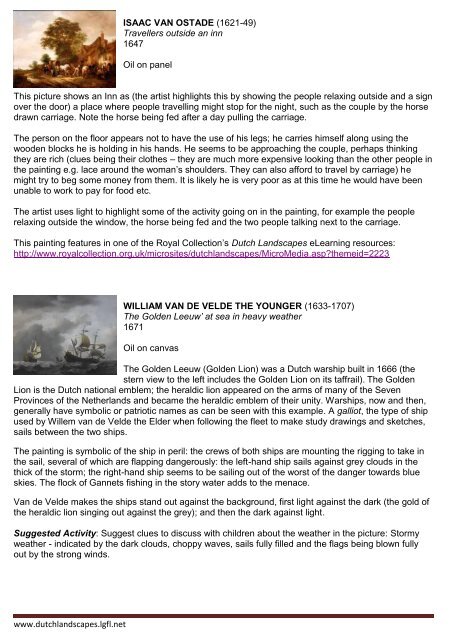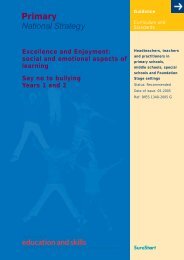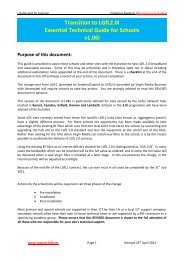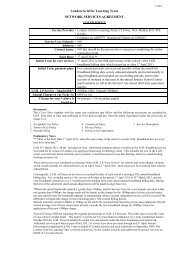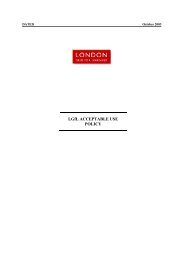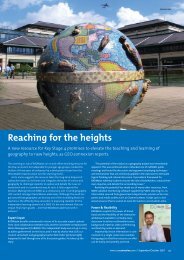Teaching Notes For Exhibition Pictures.pdf - LGfL
Teaching Notes For Exhibition Pictures.pdf - LGfL
Teaching Notes For Exhibition Pictures.pdf - LGfL
You also want an ePaper? Increase the reach of your titles
YUMPU automatically turns print PDFs into web optimized ePapers that Google loves.
ISAAC VAN OSTADE (1621-49)<br />
Travellers outside an inn<br />
1647<br />
Oil on panel<br />
This picture shows an Inn as (the artist highlights this by showing the people relaxing outside and a sign<br />
over the door) a place where people travelling might stop for the night, such as the couple by the horse<br />
drawn carriage. Note the horse being fed after a day pulling the carriage.<br />
The person on the floor appears not to have the use of his legs; he carries himself along using the<br />
wooden blocks he is holding in his hands. He seems to be approaching the couple, perhaps thinking<br />
they are rich (clues being their clothes – they are much more expensive looking than the other people in<br />
the painting e.g. lace around the woman’s shoulders. They can also afford to travel by carriage) he<br />
might try to beg some money from them. It is likely he is very poor as at this time he would have been<br />
unable to work to pay for food etc.<br />
The artist uses light to highlight some of the activity going on in the painting, for example the people<br />
relaxing outside the window, the horse being fed and the two people talking next to the carriage.<br />
This painting features in one of the Royal Collection’s Dutch Landscapes eLearning resources:<br />
http://www.royalcollection.org.uk/microsites/dutchlandscapes/MicroMedia.asp?themeid=2223<br />
WILLIAM VAN DE VELDE THE YOUNGER (1633-1707)<br />
The Golden Leeuw’ at sea in heavy weather<br />
1671<br />
Oil on canvas<br />
The Golden Leeuw (Golden Lion) was a Dutch warship built in 1666 (the<br />
stern view to the left includes the Golden Lion on its taffrail). The Golden<br />
Lion is the Dutch national emblem; the heraldic lion appeared on the arms of many of the Seven<br />
Provinces of the Netherlands and became the heraldic emblem of their unity. Warships, now and then,<br />
generally have symbolic or patriotic names as can be seen with this example. A galliot, the type of ship<br />
used by Willem van de Velde the Elder when following the fleet to make study drawings and sketches,<br />
sails between the two ships.<br />
The painting is symbolic of the ship in peril: the crews of both ships are mounting the rigging to take in<br />
the sail, several of which are flapping dangerously: the left-hand ship sails against grey clouds in the<br />
thick of the storm; the right-hand ship seems to be sailing out of the worst of the danger towards blue<br />
skies. The flock of Gannets fishing in the story water adds to the menace.<br />
Van de Velde makes the ships stand out against the background, first light against the dark (the gold of<br />
the heraldic lion singing out against the grey); and then the dark against light.<br />
Suggested Activity: Suggest clues to discuss with children about the weather in the picture: Stormy<br />
weather - indicated by the dark clouds, choppy waves, sails fully filled and the flags being blown fully<br />
out by the strong winds.<br />
www.dutchlandscapes.lgfl.net
CLAUDE GELLEE, CALLED ‘LE LORRAIN’ (1604/5-82)<br />
Harbour scene at sunset<br />
1643<br />
Oil on canvas<br />
This painting can be said to be an example of a ‘pathetic fallacy’ – where<br />
many aspects of the painting reflect the emotions of the people in it. <strong>For</strong><br />
example, the people appear quite relaxed, maybe happy. Some are<br />
walking along chatting; others are leisurely unloading a boat. And one person can be said to be very<br />
relaxed! (asleep on the sacks).<br />
The mood of the people is highlighted through:<br />
o The calm waters of the harbour<br />
o The low sun in the sky and late afternoon calmness<br />
o Birds flying in the sky<br />
o The relaxed feel of the ships anchored in the harbour, perhaps bobbing up and down with<br />
the small swell<br />
The effect of these small waves lapping on the harbour’s edge may add to this effect.<br />
Suggested Activity: Discuss with the group the idea of a ‘Pathetic Fallacy’, how a painting reflects<br />
the mood of the people in it. <strong>For</strong> example…….. if there was a painting of two people in love do the<br />
group think the sky would be painted as a bright sky with fluffy clouds or a dark sky with stormy<br />
clouds? What would a painting look like if the people in it were angry?<br />
This painting features in one of the Royal Collection’s Dutch Landscapes eLearning resources:<br />
http://www.royalcollection.org.uk/microsites/dutchlandscapes/MicroMedia.asp?themeid=2223<br />
KAREL DU JARDIN (1626-1678)<br />
A Muleteer and two men playing the game of Morra<br />
1650-52<br />
Oil on canvas<br />
This painting shows the game of ‘Morra’ taking place between two people<br />
somewhere in Rome.<br />
The artist was not from Rome, where this is painted, and therefore would have<br />
found watching this game quite fascinating. This was a place of different customs in comparison to what<br />
the artist was used to. The game is still played today!!<br />
Here are they rules – (tip - search for “Morra” on YouTube).<br />
There are many variations of Morra, but most can be played with two, three, or more players. In the<br />
most popular version, all players throw out a single hand, each showing zero to five fingers, and call out<br />
loud (not too loud if you are in the gallery!) their guess at what the sum of all fingers shown will be. If<br />
one player guesses the sum, that player earns one point. The first player to reach three points wins the<br />
game.<br />
www.dutchlandscapes.lgfl.net
In another version one person is designated the "odds" player while the other is labeled "evens".<br />
Players hold one hand out in front of them and count together to three (chanting "One, two, three,<br />
SHOOT!"). On "shoot", both players hold out either one or two fingers. If the sum of fingers shown by<br />
both players is an even number (i.e. two or four) then the "evens" player wins; otherwise the "odds"<br />
player is the winner. Since there are two possible ways to add up to three, both players have an equal<br />
chance of winning.<br />
JOHANNES LINGELBACH (1622 – 1674)<br />
Figures before a Locanda, with a View of the Piazza del Popolo, Rome<br />
c.1645 – 50<br />
Oil on Canvas<br />
This painting, featuring a location outside a locanda (hostel) highlights an area<br />
of Rome the artist lodged in during his first years there. During that time he<br />
would have become accustomed to the sights, characters and different way of<br />
life that he would have been used to back in his native northern Europe. The painting features a<br />
number of different street traders: a ciambella (ring-shaped cake) seller, who also runs a girella (a type<br />
of roulette wheel banned in Rome at this time). An old man mends a boy’s shoe whilst he sits in the dirt<br />
and a blind musician plays a guitar, whilst sat in the hostel doorway.<br />
Suggested Activity: Interesting features – How can we tell the musician in the doorway is blind? (is the<br />
stick next to him the only clue?). Can you spot the child behind the group of gamblers? Do you think he<br />
or she is interested in the game or the basket of bread/cakes underneath (note: this character does not<br />
even have shoes on).<br />
ADAM WILLAERTS (1577-1664)<br />
The Embarkation at Margate of Elector Palatine and Princess Elizabeth<br />
1623<br />
Oil on Canvas<br />
This is an interesting painting in that it does not feature Holland (even<br />
though the horizon is dotted with windmills), but Margate in England (yet it was painted by a Dutch<br />
artist.). The painting features King James I in 1613 (can you find him?), seeing off his daughter<br />
Princess Elizabeth and her husband Frederick, Elector Palatine. The couple are about to board the<br />
Prince Royal, a ship built in 1610 for Henry Prince of Wales.<br />
One interesting aspect of the painting is the awkward composition and use of proportion. Much of the<br />
painting does not ‘look right’. <strong>For</strong> example the oversized guards to the left of the picture and the people<br />
on horseback on the beach. This is a great example to show children that even the best artists do not<br />
‘get it right’.<br />
Suggested Activity: Find out about Prince Henry – what happened to him? Can the pupils spot the HP<br />
Monograms, Prince of Wales feathers and figurehead of St. George on a horse on the ship intended for<br />
the prince?<br />
This painting features in one of the Royal Collection’s Dutch Landscapes eLearning resources:<br />
http://www.royalcollection.org.uk/microsites/dutchlandscapes/MicroMedia.asp?themeid=2223<br />
www.dutchlandscapes.lgfl.net
ALBERT CUYP (1620 – 1691)<br />
A Page with Two Horses<br />
Late 1650s<br />
Oil on Canvas<br />
This painting provides a number of interesting discussion points. The<br />
location is difficult to pin down, as it is almost certainly made up. The<br />
artists is trying to suggest the landscape in this painting is perhaps in a southern region of Europe,<br />
perhaps Itlay but he has not been to these places himself. Instead he uses the architecture of old<br />
Roman towns close to where he lives as inspiration for his painting.<br />
The Page in the middle of the painting is very well dressed in rich clothing, perhaps provided to him by<br />
his master. The man in the black clothing (perhaps the boy’s master) appears to be very rich,<br />
highlighted by the amount of lace he is wearing and the gold threading on his clothes.<br />
Suggested Activity: Bearing in mind the characters in the painting, who do you think the artist has<br />
focussed on as the main character? Is the boy really a slave? Ask the children to look at the clues in the<br />
painting and consider what job he might have.<br />
JACOB VAN RUISDAEL (1628/9 – 1682)<br />
Evening Landscape: A Windmill by a Stream<br />
Mid to late 1650s<br />
Oil on Canvas<br />
This is an almost stereotypical image of the Dutch landscape, with the<br />
windmill in the foreground and the low lying countryside in the<br />
background. The painting focuses the viewer’s eye on the windmill,<br />
they symbol of the Dutch Republic which played a significant role in the<br />
country’s new industry and resulting wealth. In addition to the production of flour the windmills pumped<br />
water through the drainage ditches of the lowlands allowing the reclaimed land from the sea to be used.<br />
To the left of the windmill people are working in the ‘Bleaching Fields’ where newly produced linen and<br />
cloths were laid out in the sun.<br />
Suggested Activity: Research the importance of the windmills for Dutch people at this time. How and<br />
what were they used for? Could anything be learnt from them or applied to today’s industry or need for<br />
renewable power sources?<br />
www.dutchlandscapes.lgfl.net


